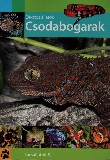New habitat Goniurosaurus luii Grismer, Viets et Boyle, 1999 in Vietnam

According to the latest terminological changes though was the species G. murphyi systematically revalued and indicated as synonym of species G. lichtenfelderi subspecies lichtenfelderi and at the same time Goniurosaurus luii was selected from the family G. lichtenfelderi, Mocquard, 1897.This species was described from the sphere of G. lichtenfelderi (on the mainland) and G. lichtenfelderi hainanensis (on the island Hainan), which is sympatric with.

It differs from them with bigger size and three pairs of spinal stripes (against two by G. lichtenfelderi), while as Terra typica is presented region of Pingxiang, Gungxi Province, Peoples Republic of China. Besides that has G. luii disjoint area, divided into two or more each other isolated regions, while in the literature is mentioned South continental China (agricultural land in surroundings of Longzhou and Pingxiang) and island Hainan (Ch'iungchung) (Vergner, I., Ještěři I. 2001). However not Vietnam.

But exactly here under the influence of territory’s character (remains of little scientific measured rainforests with rocky sections and caves) mainly in the North of Vietnam finding of new habitats with appearance of other not yet discovered and described taxons of (not only) this species can be predicted. The changes of taxonomic status of before described species and subspecies of gecko family Goniurosaurus can’t be excluded.

In the time of creating of publication Ještěři I. 2001 tough the population Goniurosaurus luii in Vietnam wasn’t determined as G. luii, but as native G. lichtenfelderi. It can be predicted that certain problem would be the determination of area‘s borders of G. luii in Vietnam towards species G. lichtenfelderi with the taxon murphyi, which became its synonym (Vergner I. in verb. 2006).
Goniurosaurus luii is slim, big gecko with markedly grainy skin, general size of 197-214 mm,
while the tail forms approximately 46% of the whole size. Natural colour is pale, yellowy to orange,
greyish yellow to pale yellowish brown, rich black spoted, as far as single dense spots on the head
and body are in different sizes. Cross pairs of black bands create shining design – the first one from eyes rounds the neck, other three are on the back, one is on the tail’s root. Space inside between bands is intense yellow to orange. Tail is towards the end rich black, ornate with 4-5 vertical white bands. But intensity and tone of colouration is individual variable and underlies particular physiological switch, mostly between day and night. Lower part of the body is off-white. Males have 23-29 pre-anal pores.

Its natural habitat are rocky formations in tropical forests, where it occurs in surrounding of caves.
During the day it shelters in holes and also under big stones. In the night it moves on the ground, on
the rocks, also on vegetation and on boles of trees. It is active mostly from June to August, when
females lay eggs. At the end of October it shelters again.

In 2000 MUDr. Radovan Boča who came back from Vietnam at this time, presented me living individual - pregnant female of gecko. MUDr. Boča supposed that it is a member of species Eublepharis macularius (Blyth, 1854), but which doesn’t exist in Vietnam at all. After the examination of this individual I was clear that we have here the specimen of uncertain species from family Goniurosaurus. Following the available literary materials (mostly work of L. Klátil - Obrazový atlas gekonů, 1999) I supposed that given individual belongs to described species G. araneus or G. murphyi.

After developing the frames and years of research on the origin of given individual, which meanwhile laid pair of eggs, but after months in rearing unfortunately perished (Boča in verb., 2000), I sent these photos for reviewing to Mr. Poulíček, Mr. Funk and Mr. Hošek. In the matter of the determination I also addressed it to Mr. Klátil who kindly provided me contact information on Russian herpetologists who were just describing new species of family Goniurosaurus in Vietnam (2005).
Unfortunately despite of my effor I didn’t manage to communicate with them.

But more light to the determination brought the habitat – province Cao Bang in the North of Vietnam.
Finder MUDr. Boča and Ing. Marian Pacalaj, another member of expedition caught the individual in late night time at the tree in the height of 2 m above the ground with entomologic net. The habitat was found approx. 700 m above sea level, 20 km northerly from the capital of the province Cao Bang,very close to lake Thang Hen Lake (see the map). The habitat’s ground is made of limestone.
Though the research wasn’t finished. The determination of the individual was still missing.
From the same habitat (province Cao Bang) it is known also Goniurosaurus araneus.
Into question came also Goniurosaurus lichtenfelderi lichtenfelderi from South Eastern China (province Guangxi) and North Vietnam (island Norway) and continental North Eastern Vietnam, or population named G. murphyi, which was found closely to village Dang Chau in Hoang Hoa Tham, Chi Linh, Hai Hung. Another discovered species which could come into question was G. bawanglingensis Grismer, Haitao, Orlov & Anajeva, 2002. Indeed it’s similar to G. luii, but main grey colour has tan hue and mainly inhabites Chinese island Hainan. Again not Vietnam. G. luii was up to now mentioned only from South Eastern China, not from Vietnam, even if his present habitat is around 100 km from the frontier.

Therefore I sent the photo of female to my Czech colleagues with request to specify it. I would like to
thank them. Colleauge Mr. Funk, Mr. Poulíček and also Mr. Hošek indenpendently concurred that with 99 % guarantee it is Goniurosaurus luii. Given individual who didn’t live indeed and as per information that I received from MUDr. Boča it should be owned by breeder from Bratislava, but I couldn‘t neither confirm nor disprove this indication, it got it’s name finally - Goniurosaurus luii. His habitat, province Cao Bang with the capital of the same name, is interesting also with it’s climatic side. The average winter temperature is about 17ºC, summer temperature about 28 ºC. It’s population composes of few ethnics Viet/Kilh, Dao, Hoa, H'mong, Molg, Lung, Tay, Salchay, which live in districts and wards Baolac, Halang, Haquang, Hoaan, Nguyenbinh.
Goniurosaurus luii (Chinese Leopard Gecko) still remains mysterious and fascinating being which fully deserves our understanding and admiration. For all that it let us discover again one of it’s secrets...
In the end I want to thank to Mr. MUDr. Boča – the discoverer of the gecko, Mr. Ing. Pacalaj for providing information and photos from habitats, Mr. Poulíček, Mr. Funk and Mr. Hošek for their goodwill and helping by the determination, Ms. RNDr. Kramáreková from Department of Geography and Regional Development of FPV UKF Nitra for all her help, Mr. Ing. Vergner for looking through the article and his comments, Stanislava Stískalová for translating to English language and my friend Mgr. Evka Vráblová.
Text: Štefan Čambal, VIVARISTA.sk
Photos by: Ing. Marian Pacalaj and Štefan Čambal, VIVARISTA.sk
| Vytlačiť článok |
Šefredaktor | 23.8.2007 14:49 | 0 komentárov | 7463x







